AMD Ryzen 5 2400G and Ryzen 3 2200G Integrated Graphics Frequency Scaling
by Gavin Bonshor on September 28, 2018 12:30 PM EST- Posted in
- CPUs
- AMD
- GPUs
- Overclocking
- Zen
- APU
- Vega
- Ryzen
- Ryzen 3 2200G
- Ryzen 5 2400G
Ryzen 3 2200G Integrated Graphics OC Performance
Shadow of Mordor
The next title in our testing is a battle of system performance with the open world action-adventure title, Middle Earth: Shadow of Mordor (SoM for short). Produced by Monolith and using the LithTech Jupiter EX engine and numerous detail add-ons, SoM goes for detail and complexity.
The main story itself was written by the same writer as Red Dead Redemption, and it received Zero Punctuation’s Game of The Year in 2014.
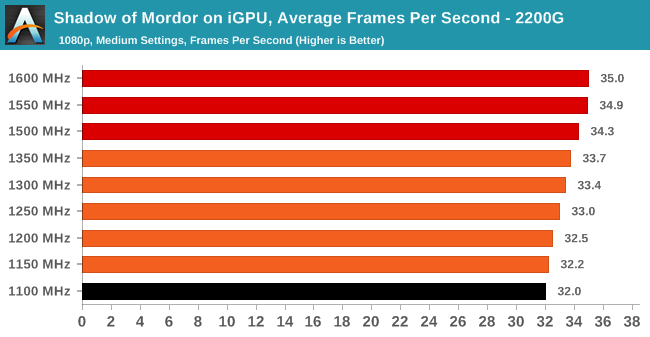
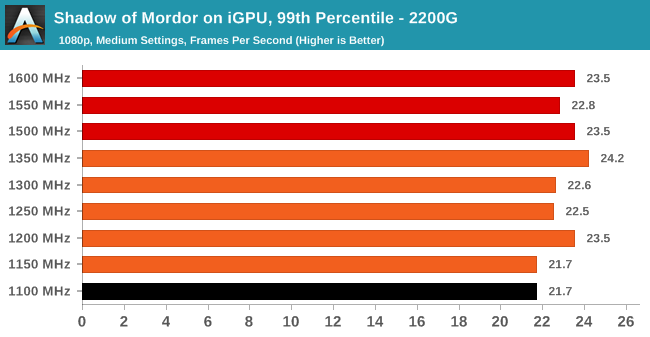
Performance in Shadow of Mordor wasn’t the best we have seen from the game testing, with average framerates gradually increasing on the 2400G. The 99th percentiles given throughout the testing was erratic to say the least.
F1 2017
Released in the same year as the title suggests, F1 2017 is the ninth variant of the franchise to be published and developed by Codemasters. The game is based around the F1 2017 season and has been and licensed by the sports official governing body, the Federation Internationale de l’Automobile (FIA).
F1 2017 features all twenty racing circuits, all twenty drivers across ten teams and allows F1 fans to immerse themselves into the world of Formula One with a rather comprehensive world championship season mode.
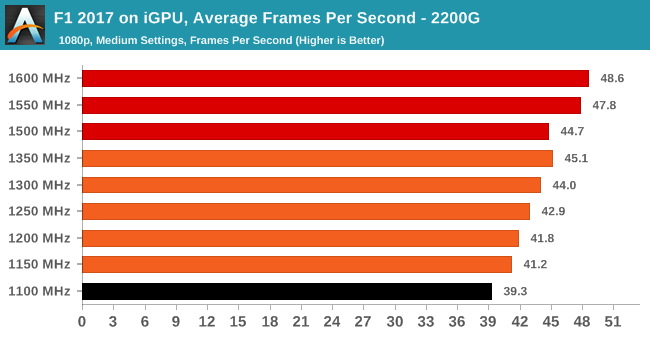
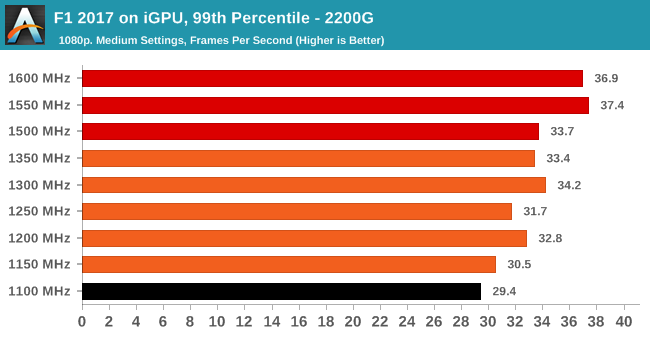
The performance throughout the testing in F1 2017 was consistent in terms of average frame rates with an overall improvement of 9 FPS. The 99th percentile testing was very inconsistent in F1 2017 on both the Ryzen 2200G, but the 2400G too.
Total War: WARHAMMER 2
Not only is the Total War franchise one of the most popular real-time tactical strategy titles of all time, but Sega delve into multiple worlds such as the Roman Empire, Napoleonic era and even Attila the Hun, but more recently they nosedived into the world of Games Workshop via the WARHAMMER series.
Developers Creative Assembly have used their latest RTS battle title with the much talked about DirectX 12 API, just like the original version, Total War: WARHAMMER, so that this title can benefit from all the associated features that comes with it. The game itself is very CPU intensive and is capable of pushing any top end system to their limits.
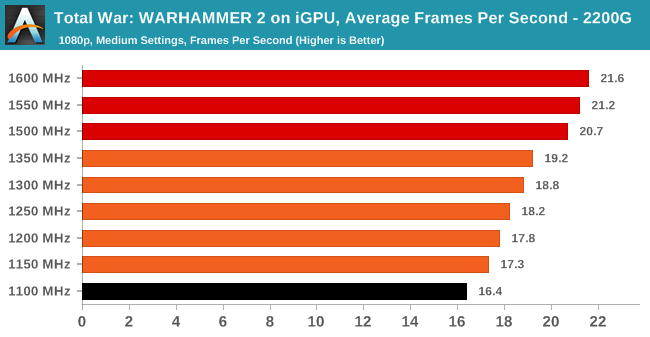

The 2200G managed to pull just under 32% in extra performance in going from 1100 to 1600 MHz on the iGPU and as with multiple games on test, the 99th percentiles of the 2400G seem somewhat capricious. This particular title uses the Warscape Engine and with the 2200G, the performance offered seems more in line with what was expected overall.


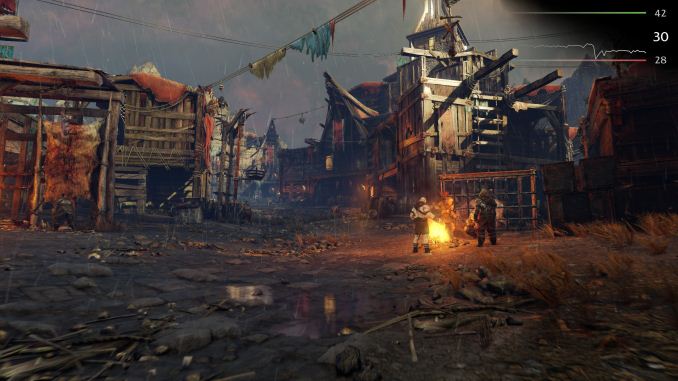
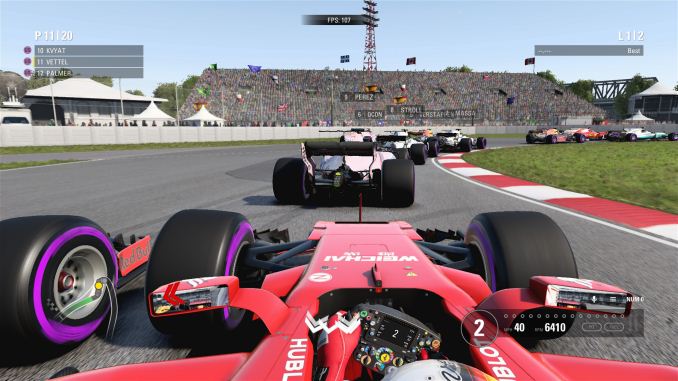
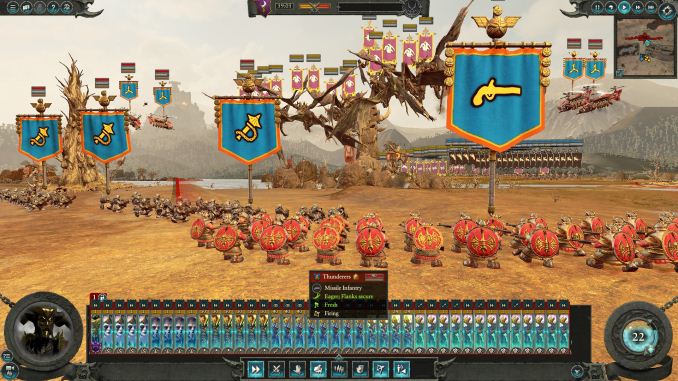








49 Comments
View All Comments
neblogai - Saturday, September 29, 2018 - link
Or a €10 Deepcool Gammaxx 200T, €15 Gammaxx 300, etc.lightningz71 - Saturday, September 29, 2018 - link
If you keep the overclock reasonable. Keep the CPU stock and push the iGPU to 1600mhz. If you push higher, it starts demanding a lot of SOC voltage, which hurts the memory controller performance. There are a few B450 boards with decent 2 phase SOC sections that would be fine there. The problem is having the option in the BIOS to actually overclock the iGPU.dromoxen - Sunday, September 30, 2018 - link
I dont think ppl are are able to push higher, 1600mhz seems to be pretty much the outer limit. It appears that the greatest increase is going from 1100mhz to 1150mhz after that the gains are much less. Power draw and heat would be nice to know . I would like to have one of these in a nuc style system as a tellybox maybe the ge's will suit better. They can only get more popular if Intel cant supply Budget chips for next 9 monthseastcoast_pete - Saturday, September 29, 2018 - link
Gavin, thanks for this last chapter of the Zen APU reviews! As mentioned by others here, it would be helpful if you could post the power draw (even just overall) figures; they usually give a good idea how much of a sweat the silicon works up. The other point is that if I would OC either the CPU or GPU on a 2200G or 2400G, I would at least try to OC the memory a bit, too. With graphics likely limited by memory speed, that seems to be a logical thing to try. If you did, any information on that combo (OC'd graphics plus OC'd memory) would be appreciated! It doesn't have to be a full list of all OC permutations.ballsystemlord - Saturday, September 29, 2018 - link
You wrote the wrong APU name down in the paragraph reading "Performance in Shadow of Mordor wasn't the best we have seen from the game testing, with average framerates gradually increasing on the 2400G."You were testing the 2200G in that section.
I know it's easy to make that mistake, I do it too.
Haawser - Saturday, September 29, 2018 - link
"For any compute related workloads, the integrated graphics frequency is ineffective whereas pure MHz on the Ryzen cores and memory frequency can play a major part in improving performance throughput. "Implying that memory overclocking isn't useful for graphics too ? Why didn't you try overclocking the graphics *and* memory, seeing as both are easy to do ? And 90% of APU users interested in gaming will anyway ?
eva02langley - Saturday, September 29, 2018 - link
I am having a similar motherboard, the MSI B450i Gaming AC plus, and the same behavior between 1350-1400MHz happen.I just put the iGPU at 1500MHz with 1.2V and it is running flawlessly in games.
Also, I am experiencing strange blinking black screen once in a while. It is like a blinking of an eye. It is kind of annoying.
Do you experience the same thing?
wilsonkf - Sunday, September 30, 2018 - link
Why don't you test at least one more faster memory speed (e.g. 3466Mhz)? This would be interesting.hashish2020 - Tuesday, October 2, 2018 - link
I hope that they end up doing that, because that will likely be the sweet spot for casual gamers like me who are thinking about getting back into building desktops.lightningz71 - Tuesday, October 2, 2018 - link
The memory controller on the 2400G is not improved over Zepplin in any measurable way. It gets unstable quickly past 3200/3333 (though, with very loose timings and good samples, there are OC examples in the 3400 range, though, stability is questionable.)Buildzoid on reddit has a video on testing. He showed that B-die can net you tight timings at 3200/3333/ but gets VERY hot above that. E-Die was showing stability and lower temperatures at 3400, but, the timings were looser to get there. No matter what, his performance testing showed that 3200/3333 with tight timings were just as fast as 3400 with loose timings, and more achievable. His absolute fastest times were with UNSTABLE runs of B-Die at 3400+ mhz with passable timings, but it required considerable cooling to occasionally complete a test.
The advantage to keeping the memory at 3200/3333 with tight timings is that you can run a bit more SOC voltage and maybe get a bit more out of the iGPU. 1600 is a reasonable overclock, but, with a bit more voltage, people are getting it past 1650 and sometimes 1700.
I haven't seen delidding results on iGPU overclocking with memory overclocking at the same time.